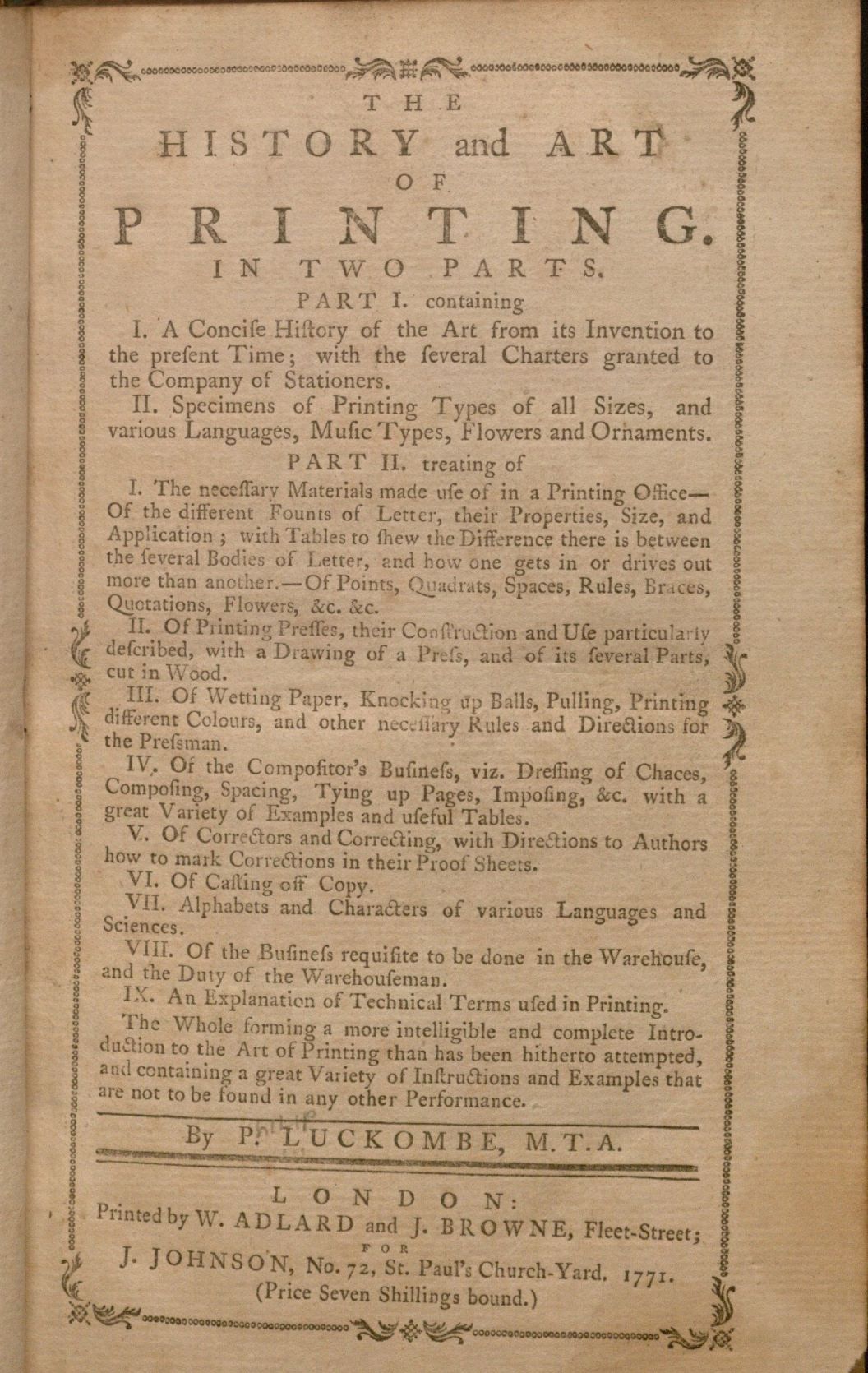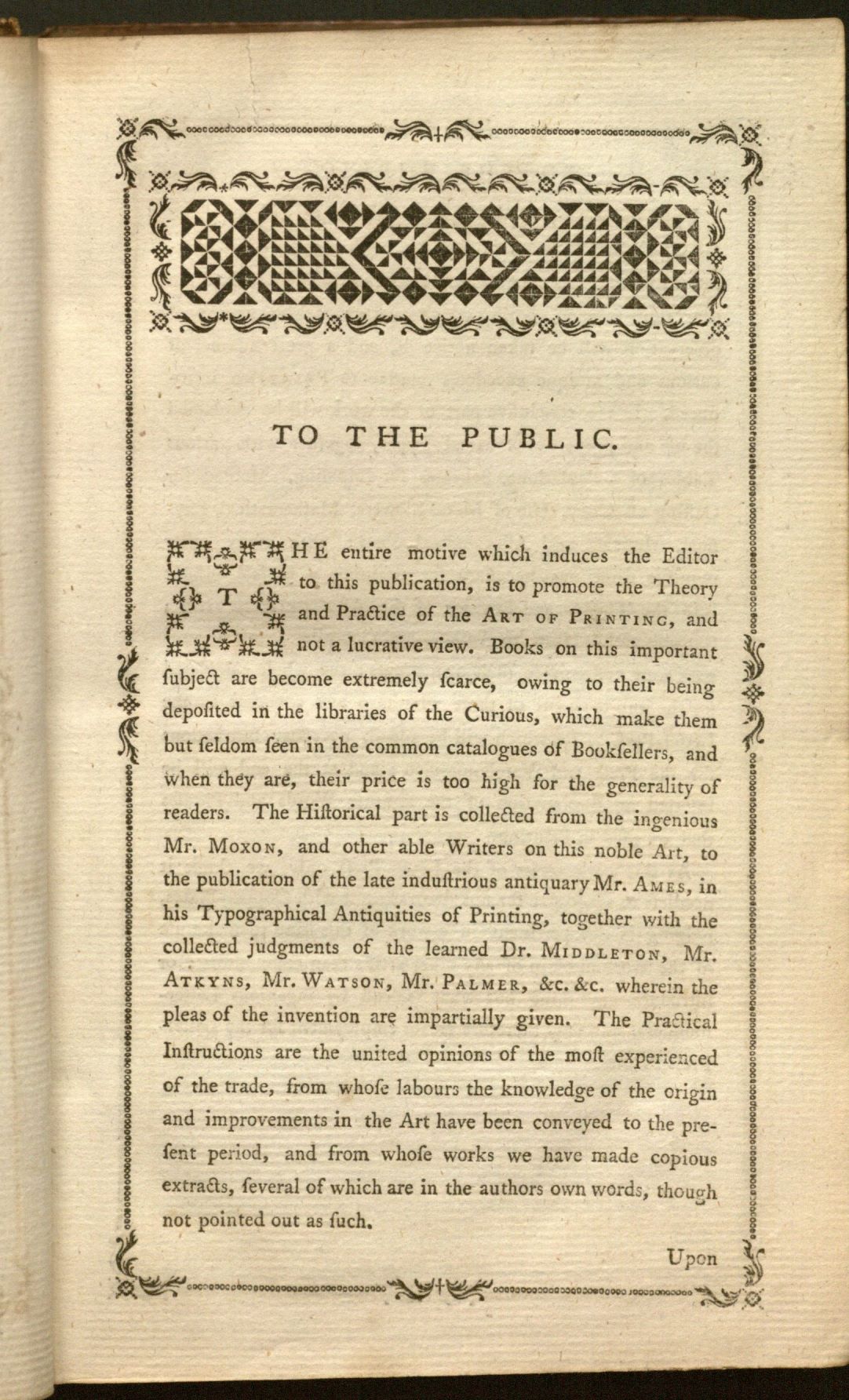Authors’ Rights and the Relativity of Luckombe’s Plagiarism
January 23rd, 2017Public Services Student Assistant Megan Fox considers printing history and changing notions of authorship in a favorite volume from the stacks.
Philip Luckombe, an eighteenth-century English printer and author, compiled the information in his book The History and Art of Printing with the express intention for it to be a reference to the general public about the history of printing from 1400 to roughly 1660 and the basic processes of historic printing. As he states in the introduction, “The entire motive which induces the Editor to this publication, is to promote the Theory and Practice of the Art of Printing… books on this subject are extremely scarce.” Luckombe’s book contains many interesting features beyond its content, including an ornamental border on all the pages and numerous examples of typefaces. Additionally, Luckcombe includes illustrations printed by letterpress, rather than metal engravings, which were common at the time but which use a different printing technique. Luckcombe observes, “As this work treats of the Letter-Press only, we think it needless to apologize for not decorating it with Copper-Plates [engravings], judging it not pertinent in work of this kind to make use of the workmanship of any other authors than compositors.” However, a previous owner of the Spencer Research Library’s copy of The History and Art of Printing may have wished Luckombe had included more illustrations; he or she has pasted an extra illustration of printers in the printshop the end of the text.
Left: The title page of Philip Luckombe’s The History and Art of Printing. London: printed by W. Adlardand J. Browne for J. Johnson, 1771. Clubb C1771.1 Right: The beginning of Luckombe’s “To the Public” preface. Click images to enlarge.
Luckombe describes all of this in his introductory “To The Public” note before the body of the text. In doing so, he also explains that the majority of the content is not actually his own, but rather “from whole works we have made copious extracts, several of which are in the author’s own words, though not pointed out as such.” As a college student, this line in the introduction struck me as ridiculous. If I tried to copy huge sections of others’ work in one of my papers with only a short note in the introduction stating I am doing so – and without even naming all of the authors from whom I am borrowing – plagiarism identification software such as SafeAssign would flag it immediately. I would get a zero on the assignment and perhaps fail the class; I might even face university sanctions. In the twenty-first century a huge emphasis is placed on the value of authorship, and citing your work is paramount to good writing and scholarship. However, as Luckombe demonstrates, this was not always the case. Plagiarism, it seems, used to be acceptable.

Section title to Luckombe’s reproduction of William Caslon’s typefaces. Caslon is one of the few people Luckombe credits in his compilation of information about the history of printing.
Luckcombe’s use of others’ work brings to the forefront the interesting question of authorship and copyright in the eighteenth century. The idea that authors “own” their words after publication and distribution was developed through European print culture, which separated the idea of owning a physical copy of a book and owning said book’s intellectual or artistic content in order to establish author’s “rights” (Feather 520-21). It was only in the eighteenth century that the idea of an ‘author’ as a career became feasible in Britain – periodicals and novels began to be produced for the general literate public, and writers no longer necessarily needed a patron to live off their writing (Hammerschmidt 1). As authorship became a plausible career, copyright protections began to be codified into law, making it harder for contemporary works to be copied the way Luckcombe copies large sections of historical texts. One example is the Statute of Anne in 1710, which allowed authors to sell their copyright to publishers for a 14 year term, with the option of renewal. These laws were also enacted to protect publishers and their arrangements to sell artistic and intellectual content, but as a result of this a greater appreciation of authorship developed.
Luckombe was capitalizing on the fact that the works he was borrowing from, mostly published between 1440 and 1600, fell outside of copyright. Luckombe does not detail how he gained access to these works and was able to reprint them, but the mere fact of their inclusion, largely without attribution, demonstrates the difference between eighteenth-century and modern-day understandings of authorship and plagiarism. Some of Luckcombe’s contemporaries may have disapproved of this, but his compilation of other authors’ original writings still indicates how the general mindset of the culture viewed it as acceptable.
In addition to their fascinating content, older books such as The History and Art of Printing also can offer us a powerful reminder that nothing in society is static. The mindsets we regard as unalterable now may be perceived as simply a twenty-first century oddity by future generations. Concepts of plagiarism and authorial property were not the same in Luckombe’s time as they are today, and they will continue to evolve in the future.
Megan Fox
Public Services Student Assistant
Works Cited
Feather, John. “Copyright and the Creation of Literary Property.” Companion to the History of the Book. Eds. Simon Eliot and Jonathan Rose. Hoboken, NJ: Wiley-Blackwell, 2009. 520-530. Print.
Hammerschmidt, Soren. “Introduction: Between Geniuses and Brain-Suckers. Problematic Professionalism in Eighteenth-Century Authorship.” Authorship Vol 4.1 (2015) p 1-4.
Luckombe, Philip. The History and Art of Printing. London: printed by W. Adlard and J. Browne for J. Johnson, 1771. Clubb C1771.1


